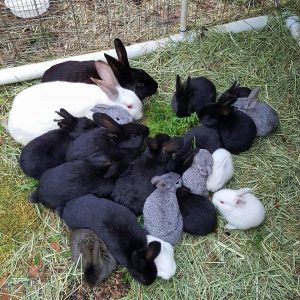Everything You Need To Know About Rabbit Gestation Period
A doe, or female rabbit, can attain sexual maturity as early as six months. Rabbits, like other living mammals, reproduce frequently to ensure the survival of the species since they are at the bottom of the food chain and are preyed upon in the wild by a variety of predators. The indications of pregnancy in a female rabbit might be difficult to spot.
A female rabbit’s gestation period is the time from conception to delivery, or kindling, of her young rabbits, or kits. A doe’s gestation span is around 31 days. It may be difficult to detect if your rabbit is pregnant throughout the gestation phase since she may not act any differently than she did before she became pregnant. During pregnancy, some female rabbits may become more aggressive, fend off male attempts, and show an increase in hunger.
The Place Where Rabbits Live and Breed
 Rabbits reside in subterranean warrens in groups called colonies, where they may hide from predators. Rabbits dig these subterranean tunnel networks, which can be found in woods, grasslands, meadows, or deserts.
Rabbits reside in subterranean warrens in groups called colonies, where they may hide from predators. Rabbits dig these subterranean tunnel networks, which can be found in woods, grasslands, meadows, or deserts.
The only time a rabbit does not live in a warren is when it is about three weeks old. Outside the warren, mother rabbits may construct a unique nursery burrow for their pups and cover it with twigs, grasses, and sometimes their own hair. According to the Arizona Sonora Desert Museum, when she leaves her pups, she covers their burrow with earth to keep them concealed and secure.
The cottontail rabbit is an exception to this rabbit warren norm. Cottontail rabbits’ nests are frequently hidden in plain sight, even in the center of a suburban garden. Cottontail nests are just depressions in the ground that the cottontail will scrape out and line with grass or straw.
Rabbits, on the other hand, prefer to go underground, and for good reason.
Many rabbits are murdered within their first year of life since they are a favorite target animal for coyotes, foxes, snakes, and owls. They rely on their good eyesight, hearing, and ability to rapidly return to their underground shelters to conceal for protection.
How many rabbits are in a litter?
 If you want to keep rabbits as pets, you should be aware that they reproduce quickly. Mother rabbits can have anything from one to fourteen offspring. A litter of six young bunnies is average for a doe. The size of the litter is determined by a variety of factors, including the doe’s age, size, and health, as well as the rabbit’s surroundings.
If you want to keep rabbits as pets, you should be aware that they reproduce quickly. Mother rabbits can have anything from one to fourteen offspring. A litter of six young bunnies is average for a doe. The size of the litter is determined by a variety of factors, including the doe’s age, size, and health, as well as the rabbit’s surroundings.
- Litter Size and Number of Litters
According to the University of Miami, the rabbit’s litter size can also vary depending on the order in which the litter is born, such as first, second, and so on.
In general, the initial litters are smaller, and when your doe (a female rabbit) approaches the optimal age for motherhood, litters continue to get larger. The litters will grow smaller as your rabbit gets older until your doe approaches the end of her bunny-bearing years.
- Kit Mortality Rate
Domestic rabbits have a relatively low newborn mortality rate, usually less than 10%.
It’s crucial to remember, though, that infant bunnies are delicate. Some newborns are just weaker than others when they are born. When this occurs, a mother rabbit may decide to forsake the weaker bunny in order to concentrate her attention and milk on the stronger youngsters.
A rabbit’s motivation is totally motivated by the necessity for the species to live. This may appear harsh since it is the human tendency to believe that the weaker ones should be treated equally, but rabbits’ nature always prioritizes the survival of their species over the life of a single individual.
New Zealand white rabbit gestation period
 A New Zealand white doe (female rabbit) becomes viable between the ages of 8 and 12 weeks and can be safely bred between the ages of 5-8 months, depending on the rabbit. The doe and/or kits may be harmed or killed if they are bred before this age. Does are fertile all year, however, the duration of the day has an effect. The gestation period is around 28–35 days, while most women give birth between 31 and 32 days.
A New Zealand white doe (female rabbit) becomes viable between the ages of 8 and 12 weeks and can be safely bred between the ages of 5-8 months, depending on the rabbit. The doe and/or kits may be harmed or killed if they are bred before this age. Does are fertile all year, however, the duration of the day has an effect. The gestation period is around 28–35 days, while most women give birth between 31 and 32 days.
Two to five days before the predicted kindling date, a nest box should be supplied for the new mother. The doe will gather fur from her abdomen and dewlap, as well as hay or other resources, to build a nest.
Hairless, deaf, and blind kits are born at first. By days 3 to 5, the kits’ fur begins to grow in, and their eyes open after 7 to 10 days. After 2 weeks, they may begin exploring and tasting outside food sources. Their mother will begin weaning them off milk at the age of three to four weeks, and the kits will transition to eating hay and pellets in the meanwhile.
The typical litter size is seven rabbits, although it can range from one to fourteen. Because rabbits are induced ovulators, if the conditions are good, a doe can get pregnant just by mating. Within 24 hours of giving birth, a doe can become pregnant.
American chinchilla rabbit gestation period
 Just like most rabbits, the gestation period of American Chinchilla Rabbits is around 26 to 36 days. Rabbits of various breeds achieve sexual maturity at different ages. Smaller breeds reach sexual maturity sooner than bigger ones. At 4 to 5 months of age, small breeds (such as the Polish) can be bred. Medium-breed dogs (such as New Zealanders and Californians) reach sexual maturity at the age of 6 to 7 months.
Just like most rabbits, the gestation period of American Chinchilla Rabbits is around 26 to 36 days. Rabbits of various breeds achieve sexual maturity at different ages. Smaller breeds reach sexual maturity sooner than bigger ones. At 4 to 5 months of age, small breeds (such as the Polish) can be bred. Medium-breed dogs (such as New Zealanders and Californians) reach sexual maturity at the age of 6 to 7 months.
When gigantic breeds (such as the Flemish Giant) are bred, they must be at least 7 months old. All rabbit breeds’ females reach sexual maturity before their male counterparts. This means that does of a similar age can be put to work before bucks of the same age.
What is the gestation period for an English lop rabbit?
 The female English Lop rabbit is recognized for being highly prolific, producing big litters of 5–12 rabbits with a gestation length of 28–35 days and having good maternal intuition. 10 months is the best age for a female English Lop rabbit to begin reproducing. They give birth after 30–32 days on average.
The female English Lop rabbit is recognized for being highly prolific, producing big litters of 5–12 rabbits with a gestation length of 28–35 days and having good maternal intuition. 10 months is the best age for a female English Lop rabbit to begin reproducing. They give birth after 30–32 days on average.
The most rapid growth of an English Lop’s ears occurs during the first 16 weeks of its life, and its ears will require special care and attention during this time. Although a baby English Lop is born with normal-sized ears, after a month, the ears will double in size every week.
The ears will be longer than the English Lop’s body at about four weeks old, and the rabbits will be more prone to mishaps or injuries, such as stumbling over their ears or accidentally scratching them often, thus extra care should be provided during this stage.
Meat rabbit gestation period
 The gestation period of a meat rabbit depends on the breed that you have chosen. Generally, it is a little over or below 1 month. You may want to prepare as many fryers as possible if you’re breeding rabbits for meat. If you primarily want to show rabbits, you may want to have only a few litters per year and space them out so that you have stock of the right age to show. For ease of record keeping, rabbit breeding cycles are commonly based on 7-day intervals.
The gestation period of a meat rabbit depends on the breed that you have chosen. Generally, it is a little over or below 1 month. You may want to prepare as many fryers as possible if you’re breeding rabbits for meat. If you primarily want to show rabbits, you may want to have only a few litters per year and space them out so that you have stock of the right age to show. For ease of record keeping, rabbit breeding cycles are commonly based on 7-day intervals.
Many commercial rabbit breeders will breed do 14 to 21 days after they have been kindled. A 35-day breed-back period is suggested. As you gain skills, you can reduce the time between kindling and breeding. Intensive breeding efforts, on the other hand, may result in an increase in the number of does cull (put down) each year owing to “burn out.”
Conclusion
In conclusion, the gestation period of rabbits is more often a little over or below a month in time. However, depending on the breed of rabbit that you have it may vary to some degree. Doing the research and having the knowledge would prepare you for the oncoming litter of kits that are arriving, which can catch you by surprise if you do not look closely at your rabbits and do preparation earlier.
https://www.rabbitproducersassociation.com/everything-you-need-to-know-about-rabbit-gestation-period/https://www.rabbitproducersassociation.com/wp-content/uploads/2021/06/Rabbit-Gestation-Period.jpghttps://www.rabbitproducersassociation.com/wp-content/uploads/2021/06/Rabbit-Gestation-Period-150x150.jpgUncategorizedA doe, or female rabbit, can attain sexual maturity as early as six months. Rabbits, like other living mammals, reproduce frequently to ensure the survival of the species since they are at the bottom of the food chain and are preyed upon in the wild by a variety of...Netherland Dwarf Rabbit domains@dmhubtraining.comAdministratorNetherland Dwarf Rabbit


Leave a Reply